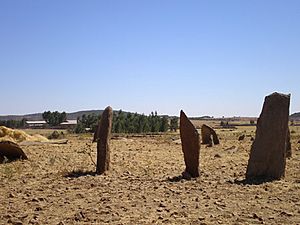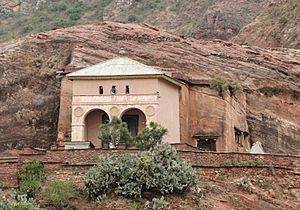Gudit facts for kids
Gudit (Ge'ez: ጉዲት) is the Classical Ethiopic name for a personage also known as Yodit in Tigray, Isato in Amharic and Ga'wa in Ţilţal, and refers to a legendary queen who, according to a late tradition, laid waste the Kingdom of Aksum and its countryside, destroyed churches and monuments, and attempted to exterminate the members of the ruling dynasty. The deeds attributed to her are recorded in oral tradition and in a variety of historical narratives.
History and stories
Information about Gudit is contradictory and incomplete. Paul B. Henze wrote, "She is said to have killed the emperor, ascended the throne herself, and reigned for 40 years. Accounts of her violent misdeeds are still related among peasants in the north Ethiopian countryside." Henze continues in a footnote:
On my first visit to the rock church of Abreha and Atsbeha in eastern Tigray in 1970, I noticed that its intricately carved ceiling was blackened by soot. The priest explained it as the work of Gudit, who had piled the church full of hay and set it ablaze nine centuries before.
There is a tradition that Gudit sacked and burned Debre Damo, an amba which at the time was a treasury and a prison for the male relatives of the king; this may be an echo of the later capture and sack of Amba Geshen by Ahmad ibn Ibrahim al-Ghazi. Gudit is known as ʿEsato in Amharic, which means "fire".
However, James Bruce presented a tradition that Dil Na'od was overthrown by Gudit, and that Mara Takla Haymanot (whom Bruce calls "Takla Haymanot") was a cousin of Gudit who succeeded her after several of her own family.
In oral tradition, Gudit is sometimes conflated with the 16th-century Muslim queen Ga'ewa of Tigray.
Ethnicity
Carlo Conti Rossini first proposed that the account of this warrior queen in the History of the Patriarchs of Alexandria, where she was described as Bani al-Hamwiyah, ought to be read as Bani al-Damutah, and argued that she was ruler of the once-powerful Kingdom of Damot, and that she was related to one of the indigenous Sidama people of southern Ethiopia.
Modern historian Enrico Cerulli discovered Arabic documents that mention a Muslim queen named Badit daughter of Maya in the tenth century who reigned under the Makhzumi dynasty. According to historian Tekeste Negash, Gudit was a Cushitic queen based at Lake Hayq in Wollo Province of Ethiopia. He further explains that there may have been a regional power struggle between Aksum and this queen of Wollo whom had ties to Yemeni traders through the port of Zeila. Somali folklore also mentions a Harla queen Arawelo, who governed from Zeila into much of the interior of the Eastern Africa.
In more recent perspectives on the issue of the ethnicity of Gudit, there has been less certainty on to her actual identity and yet more certainty on the unlikelihood of her being of Judaic belief or associated with the Beta Israel. To quote from Kaplan (1992):
Despite the Judith legend's popularity and its prominent position in the traditions of both Jews and Christians to this day, there appears to be several good reasons for rejecting the depiction of the tenth century queen of the Bani al-Hamwiyah as a Falasha. Although some Ethiopic sources do portray Yodit as a Jewess, these generally identify her as a convert rather than the product of a well entrenched indigenous religious community. The material recorded by Bruce, which contains the earliest complete account of the legend, must be considered suspect on several grounds... The suggestion that the Falasha queen Yodit, putative conqueror of Aksum, is in fact the pagan queen of the Sidama, vanquisher of the haḍani is not as startling as it might appear at first glance. By transforming the queen from a pagan to a Jewess and her primary area of activity from the south of Aksum, Christian tradition neatly places her within the primary categories of Ethiopian political-religious discourse. On some levels, the Judith traditions can be said to mirror the themes of the Kebra Nagast. Both the Queen of Sheba and Judith are depicted as converts to Judaism.
Historical evidence
It was during the office of Pope Philotheos of Alexandria when Gudit started her revolt, near the end of the reign of the king who had deposed the Abuna Petros. As Taddesse Tamrat explains, at the time "his own death in the conflict, and the military reverses of the kingdom were taken as divine retribution for the sufferings of Abuna Petros."
This chronological synchronicity with the tenure of Patriarch Philotheos, and the intervention of king Georgios II of Makuria, provides us a date of ca. 960 for Gudit. A contemporary Arab historian, Ibn Hawqal, provides this account:
The country of the habasha has been ruled by a woman for many years now: she has killed the king of the habasha who was called Haḍani [from Ge'ez haṣ́ani, modern aṣ́e or atse]. Until today she rules with complete independence in her own country and the frontier areas of the country of the Haḍani, in the southern part of [the country of] the habashi.
Another historian mentions that the king of Yemen sent a zebra to the ruler of Iraq in 969/970, which he had received as a gift from the Queen of al-Habasha.
See also
 In Spanish: Gudit para niños
In Spanish: Gudit para niños



